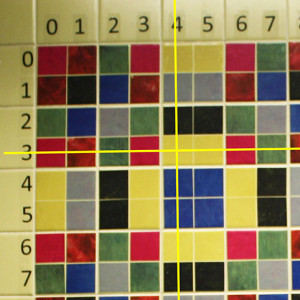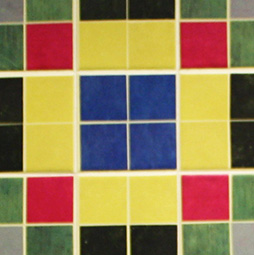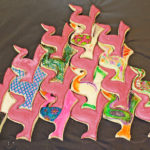Those of us of a certain (large) age will remember the colorful mod art of the late 1960s; think Peter Max or the Beatles’ Yellow Submarine. Professor Jan Minton’s HNRS 301: Mathematics and Art class has decorated a Trexler stairwell with what is truly mod art. Modular arithmetic, that is. An example of modular arithmetic is (almost) clock arithmetic, where 11+4=3 because 4 hours after 11:00 is 3:00. The “almost” comes into play because mod 12 arithmetic uses the numbers 0, 1, 2, …, 11. It is still true that 11+4=3 mod 12, but we would say that 9+3=0 mod 12 instead of 9+3=12. One definition of the value of x mod y is the (positive) remainder when x is divided by y. 15 mod 12 = 3 because when you divide 15 by 12 you get 1 with a remainder of 3.
Modular arithmetic may seem a little weird, but it has numerous important applications beyond clock arithmetic. Its usefulness is tied to its ability to reveal important patterns. For example, if you square an odd number (3 squared is 9, 5 squared is 25, and so on) you will always get a number that equals 1 mod 4. So quickly answer the following: is 403 a perfect square? It can’t be, because when you divide 403 by 4 you get a remainder of 3, and all odd squares have remainders of 1.
So here (finally) is the art: the patterns revealed by modular arithmetic are often very pleasing to the eye. The stairwell is decorated with (x2 + y2) mod 9. Choose a value for x (say, x=4) and locate the vertical line of tiles between the x-value at the top and the x-value at the bottom. Choose a value for y (say y=3) and locate the horizontal line of tiles between the y-value on the left and the y-value on the right. The lines intersect in one place. The color pattern at that location is determined by x2 + y2 mod 9; in our example, 16+9=25 mod 9 = 7. The yellow square represents 7. Where else do you see yellow? See if you can explain the borders of yellow squares that form around the blocks of blue.
It is interesting to see what happens when you use the same function with a different modulus, like x2 + y2 mod 11 or x2 + y2 mod 12. Some of the results are intricate and beautiful, some are not. As with fractals, the fact that fairly simple mathematical formulas can create such detailed patterns is surprising and perhaps revealing about life in general.












